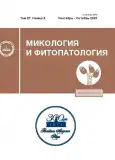First data on nivicolous myxomycetes in the “Bitsevsky forest” natural and historical park (Moscow, Russia)
- Authors: Gmoshinskiy V.I.1, Kireeva N.I.2
-
Affiliations:
- Lomonosov Moscow State University
- Independent researcher
- Issue: Vol 57, No 5 (2023)
- Pages: 372-377
- Section: SHORT COMMUNICATIONS
- URL: https://journals.rcsi.science/0026-3648/article/view/138092
- DOI: https://doi.org/10.31857/S0026364823050045
- EDN: https://elibrary.ru/YSCKLM
- ID: 138092
Cite item
Full Text
Abstract
Preliminary studies in the northern part of the “Bitsevsky forest” natural and historical park resulted in the collection of 79 specimens of nivicolous myxomycetes belonging to 6 species from 3 genera. This is the first record of nivicolous myxomycetes in urban parks in lowlands. Photographs of sporocarps and micromorphological structures are given for each species. Lamproderma ovoideoechinulatum var. microspora, L. zonatopulchellum, and Meriderma carestiae var. carestiae were found for the first time in Moscow Region. The data indicate that high level of anthropogenic pressure, namely trampling and moderate improvement does not restrict sporulation of nivicolous species.
About the authors
V. I. Gmoshinskiy
Lomonosov Moscow State University
Email: rubisco@list.ru
Russia, 119234, Moscow
N. I. Kireeva
Independent researcher
Author for correspondence.
Email: espoir87@mail.ru
Russia, 115563, Moscow
References
- Anonymous. Retromap. German aerial photography 1939–1943 years. 2023. http://retromap.ru/061942_55.644552, 37.578005. Accessed 07.05.2023.
- Bortnikov F.M., Matveev A.V., Gmoshinskiy V.I. et al. Myxomycetes of Russia: a history of research and a checklist of species. Karstenia. 2020. V. 58 (2). P. 316–373. https://doi.org/10.29203/ka.2020.502
- Erastova D.A., Novozhilov Yu.K. Nivicolous myxomycetes of the lowland landscapes of the Northwest of Russia. Mikologiya i fitopatologiya. 2015. V. 49 (1). P. 9–18.
- Gmoshinskiy V.I. Myxomycetes of Moscow and Moscow region. PhD Thesis, Moscow, 2013 (in Russ.).
- Gmoshinskiy V.I., Kireeva N.I. The first data on nivicolous myxomycetes (Amoebozoa) of the Prioksko-Terrasny Reserve (Moscow Region, Russia). Phytotaxa. 2023 (in press).
- Grossart H.-P., Wurzbacher C., James T.Y. et al. Discovery of dark matter fungi in aquatic ecosystems demands a reappraisal of the phylogeny and ecology of zoosporic fungi. Fungal Ecol. 2016. V. 19. P. 28–38. https://doi.org/10.1016/j.funeco.2015.06.004
- Ishikawa M. Thermal regimes at the snow–ground interface and their implications for permafrost investigation. Geomorphology. 2003. V. 52. P. 105–120. https://doi.org/10.1016/S0169-555X(02)00251-9
- Istomina I.I., Pavlova M.E., Terechin A.A. Population structure of Corydalis intermedia (L.) Merat in the “Bitsevsky forest” natural and historical park. Vestnik RUDN, seriya agroecologia i zhivotnovodstvo. 2014. Issue 4. P. 14–29 (in Russ.).
- Korobko M.Yu. Findings in Bittsevo Forest: Some results of the latest historical and local history research in Moscow. Moskovskiy zhurnal. 2013. Issue 1. P. 68–79 (in Russ.).
- Kuhnt A. Bemerkenswerte Myxomycetenfunde: Neue Arten, Neukombinationen und Nachweise seltener Arten, Teil 2. Bayerischen Botanisch. Gesellschaft. 2019. V. 89. P. 139–222.
- Lado C. 2005–2023. An online nomenclatural information system of Eumycetozoa. http://www.nomen.eumycetozoa.com. Accessed 15.05.2023.
- Pinheiro Velloso J.R., Putzke J., Schmitz et al. Dianema nivale – A myxomycete (Amoebozoa) new to the Antarctic. Polar Science. 2020. V. 26. 100598. https://doi.org/10.1016/j.polar.2020.100598
- Polyakova G.A., Melanokhin P.N. Problems of preserving rare species in the natural park of Bitza Forest. Aktualnye problemy lesnogo kompleksa. 2007. Issue 19. P. 148–151 (in Russ.).
- Ronikier A., Ronikier M. How ‘alpine’ are nivicolous myxomycetes? A worldwide assessment of altitudinal distribution. Mycologia. 2009. V. 101. P. 1–16. https://doi.org/10.3852/08-090
- Schnittler M., Dagamac N.H.A., Woyzichovski J. et al. Biogeographical patterns in myxomycetes. In: C. Rojas, S.L. Stephenson (eds). Myxomycetes: biology, systematics, biogeography and ecology. Academic Press, Oxford, 2022, pp. 377–416.
- Schnittler M., Erastova D.A., Shchepin O.N. et al. Four years in the Caucasus – observations on the ecology of nivicolous myxomycetes. Fungal Ecol. 2015. V. 14. P. 105–115. https://doi.org/10.1016/j.funeco.2015.01.003
- Singer H., Moreno G., Illana C. Mountainous and nivicolous myxomycetes described by Charles Meylan. A SEM-study. Österreichische Z. Pilzkunde. 2005. V. 14. P. 11–29.
- Vlasenko A.V. Species diversity and taxonomic structure of slime molds in the intrazonal and zonal habitats plains area south of West Siberia. Rastitelnyy mir aziatskoy Rossii. 2013. V. 2 (12). P. 3–11 (in Russ.).
- Vlasenko A.V. Epiphytic myxomycetes on the bark of Salix and Populus in the southeast of Western Siberia. Samarskiy nauchnyy vestnik. 2020. V. 9 (4). P. 34–38 (in Russ.). https://doi.org/10.17816/snv202094104
- Wrigley de Basanta D., Estrada-Torres A. Techniques for recording and isolating myxomycetes: updated. In: C. Rojas, S.L. Stephenson (eds). Myxomycetes: biology, systematics, biogeography and ecology. Academic Press, Oxford, 2022, pp. 417–451.
- Yajima Y., Inaba S., Degawa Y. et al. Ultrastructure of cyst-like fungal bodies in myxomycete fruiting bodies. Karstenia. 2013. V. 53 (1–2). P. 55–65. https://doi.org/10.29203/ka.2013.458
- Yatsiuk I., Leontyev D.V. Two species of nivicolous myxomycetes that formed fruiting bodies during three spring seasons in the lowlands of the Eastern Ukraine. Phytotaxa. 2020. V. 437 (3). P. 147–155. https://doi.org/10.11646/phytotaxa.437.3.3
- Yatsiuk I., Leontyev D.V., López-Villalba Á. et al. A new nivicolous species of Lamproderma (Myxomycetes) from lowland and mountainous regions of Europe. Nova Hedwigia. 2023. V. 116 (1–2). P. 105–136. https://doi.org/10.1127/nova_hedwigia/2023/0807
- Власенко А.В. (Vlasenko) Видовое разнообразие и таксономическая структура миксомицетов зональных и интразональных биотопов равнинной территории юга Западной Сибири // Растительный мир Азиатской России. 2013. № 2 (12). С. 3–11.
- Власенко А.В. (Vlasenko) Эпифитные миксомицеты на коре Salix и Populus на юго-востоке Западной Сибири // Самарский научный вестник. 2020. Т. 9 (4). С. 34–38.
- Гмошинский В.И. (Gmoshinskiy) Миксомицеты Москвы и Московской области. Дисс. … к.б.н. М.: МГУ, 2013. 690 с.
- Истомина И.И., Павлова М.Е., Терехин А.А. (Istomina et al.) Структура популяции хохлатки промежуточной (Corydalis intermedia (L.) Merat), в природно-историческом парке “Битцевский лес” // Вестник РУДН, серия Агрономия и животноводство. 2014. № 4. С. 14–29.
- Коробко М.Ю. (Korobko) Находки в Битцевском лесу: о некоторых итогах новейших историко-краеведческих изысканий в Москве // Московский журнал. 2013. № 1. С. 68–79.
- Полякова Г.А., Меланхолин П.Н. (Polyakova, Melankholin) Проблемы сохранения редких видов природного парка “Битцевский лес” // Актуальные проблемы лесного комплекса 2007. № 19. С. 148–151.











